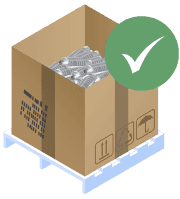Evaluation Intelligence
What Can Be Accomplished with Catalytic Converter Data?

During catalytic converter recycling, a lot of data is produced. But being able to make sense of it is a major concern for automotive and scrap metal recyclers.
Traditionally, the focus has been on the average value of a unit. But for recyclers who are serious about data tracking and maximizing their profits from catalytic converter recycling, there’s a lot more information out there.
That’s why it’s time to rethink what your converter data can do for you. Below are insights that can help you optimize your business by using the information you get from recycling spent autocats.
Why are catalytic converters valuable?
Catalytic converters are essential to internal combustion engines and are critical to the high-temperatures of a vehicle’s exhaust systems. They also allow automakers to meet emission regulations.
They work by transforming toxic pollutants emitted by your car, like carbon monoxide, nitrogen oxides, and hydrocarbons, into less harmful emissions, like carbon dioxide.
These chemical reactions are possible because the surface area of the honeycomb substrate inside the converter is coated in platinum, palladium, and rhodium. These platinum group metals (PGMs) are used primarily to regulate vehicle emissions, specifically in the exhaust system.
PGMs are hard to mine, since some of them are byproducts of mining other ores. Today, a lot of the current PGM supply relies heavily on recycled material.
This makes catalytic converters incredibly valuable!
But not all of them are built the same. There are several types of catalytic converters, and the most successful recyclers are those who are able to understand each.
Separating by catalytic converter types
Recyclers who perform separate assays of the various types of autocatalysts have a better success rate. Separating your material for assay means higher profits, and the key is knowing the five different types of catalytic converters.
OEM ceramic
Original equipment manufacturer (OEM) converters are converters that were manufactured by the same carmaker. The base material of these particular converters is cordierite ceramic that has been wash-coated with platinum, palladium, and rhodium.
OEM ceramic converters make up roughly 95% of all autocatalysts and have the highest precious metal loadings.
OEM metallic
If you were to cut open an OEM ceramic and an OEM metallic converter, you’d find the same honeycomb structure of the ceramic substrate but a different internal composition. The insides of OEM converters are made up of 409 stainless steel that is also wash-coated with valuable metals.
They represent the other approximately 5% of converters in the marketplace and should be processed differently than ceramic cordierite units when recycling.
DPFs
Diesel particulate filter converters are specifically designed for diesel engines, and can be split into two categories.
High-grade DPFs contain a higher concentration of platinum group metals (PGMs). They’re worth the effort of recycling since it is easier to recover the precious metals they contain.
Low-grade DPFs face a lot more issues. Because of the the high silicone carbide content, many smelting facilities charge extra fees for recycling DPF converters.
Aftermarkets
Aftermarket converters replace OEM converters when they fail, and contain 90% less PGMs than OEMs. Even though they contain less precious metals, they are made from the same cordierite ceramic base.
Bead converters
Bead converters hold the crown for being the first ever converters on the market. They were commonly found in light-duty trucks.
There aren’t that many left to recycle, but when they do appear, they are processed separately. That’s because the concentration of precious metals they contain is closer to the amount found in aftermarket cats.
Why does partnering with a catalytic converter processor give you more data on your material?
Toll refiners use assay analysis to determine the recoverable amount of precious metals in your recycled catalytic converters. They cut, grind, and sample catalyst material before putting them through XRF and ICP machines.
These machines use advanced analysis technology to identify the exact amount of platinum, palladium, and rhodium in recycled converters. These accurate data points can be used to optimize your business and maximize returns.
What are the benefits of separating catalyst material?
Getting a separate assay by converter type will determine the exact amount of platinum, palladium, and rhodium found in each material type.
Scrap metal and automotive recyclers that separate their material will get a clear picture of the value by each type. In turn, this allows them to generate more targeted profits and have better control of their inventory, both when buying or selling material.
Should you process combined catalytic materials?
Processing a combination of materials won’t produce accurate assay results and won’t give you the true value of your material. If the substrates are mixed for assay, the laboratory machinery will deliver results based on improper scientific assumptions since there won’t be a precise reading for each material type.
Processing combined materials is common in the industry, but it doesn’t benefit businesses selling autocatalyst material. When mixing material types, recyclers get further away from the true value of their recycled catalytic converters.
Smaller lots can provide more accurate information on your catalyst material
Getting accurate compensation for your converter material is always a good thing. Being able to track results from multiple locations is even better. However, the only way to accomplish this, for most companies, is to look for a converter processor that is able to offer assay results on small amounts of catalytic converters.
Working with a company that offers small lot assays allows for faster material returns and location-based information.
Instead of waiting to collect 1,000 or more converters, material can be shipped out much sooner and recyclers can protect themselves from changes in PGM prices.
Separating the various categories of converters into smaller lots will produce more accurate data that will keep you one step ahead of your competitors and provide real control over this valuable product.
What is considered a small lot?
Accurate assays are now being done on as few as 100 automotive converters or 200 pounds of ceramic. This is changing the way data can be analyzed and managed. With a lot size of 100 converters, an auto recycler of any size can separate each of the five different converter types, which means better results and improved data tracking.
Clearer precious metal market insights
Separating materials and small lot assays makes it much easier to spot data spikes that can be used to track profits and losses. If a company is also purchasing converter units at scale and is not separating the lots between production converters and purchased material, there is an even bigger potential for lost profit.
In the catalytic converter recycling marketplace today, there is a lot of information available regarding the value of converters. If a company doesn’t have a ready source for that information, it could be at risk for dumping of low-grade material. Partnering with a converter processor that is able to provide instant converter feedback will end this practice and provide the opportunity to make converters a higher profit core.
PMR believes that transparency and knowledge-sharing empowers recyclers to make smart business decisions and capitalize on a high market. Visit PMR’s Resource Center for converter information and industry updates.
For more questions on small converter lots and assaying, contact us.

